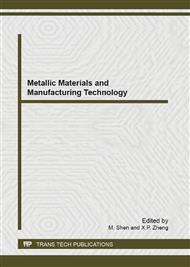p.190
p.194
p.200
p.204
p.208
p.212
p.216
p.220
p.225
Establishment of Mathematical Relation Model between Dislocation Motion and Machining Deformation of Titanium Alloy Monolithic Component
Abstract:
According to dislocation dynamics, a distribution equation of mobile dislocations during the deformation of monolithic component was established. Slip deformation was solved through dislocation density and Burgers vector, and then the mathematical relationship between slippage and plastic deformation was established. Thus the mathematical relation model between dislocations and the machining distortion of monolithic component was established by plastic deformation as intermediate variable. It is shown that the machining distortion of monolithic component is upward embossment, and its maximum deformation occurs near the middle of the beam. The amount of machining distortion is directly proportional to the stress field at different depths of the surface layer, proliferation strength of dislocation and the length of the work piece, and inversely proportional to the thickness of the work piece.
Info:
Periodical:
Pages:
212-215
Citation:
Online since:
September 2013
Price:
Сopyright:
© 2013 Trans Tech Publications Ltd. All Rights Reserved
Share:
Citation:


